Experimental and Numerical Studies of Gas Permeability through Orthogonal Networks for Isotropic Porous Material
Abstract
1. Introduction
- (a)
- Sub-capillary stream when the movement is forced under pressure and is carried out at a higher temperature;
- (b)
- Capillary stream that is observed when capillary forces and the surface tension occur;
- (c)
- Super-capillary stream that emerges under the action of gravity forces and described by general laws of hydraulics.
- (a)
- Laminar flow that is observed when molecules collide with one another within the extent of the capillaries’ radii;
- (b)
- Diffusion that occurs as an automatic process of mixing gas particles until their composition is fully completed;
- (c)
- Knudsen transport, Kn, defined as a number of collisions of a particle with walls of pores with respect to a total number of collisions among particles [27].
2. Materials and Method
2.1. Experimental Procedure
2.2. Numerical Research
3. Results and Discussion
3.1. Experimental Assessment
3.2. Numerical Assessment
4. Conclusions
Funding
Institutional Review Board Statement
Informed Consent Statement
Data Availability Statement
Conflicts of Interest
Nomenclature
| List of major signs | ||
| a | edge of the cube | m |
| b | vector of mass forces (acceleration of gravity) | m/s2 |
| c | constant | |
| d | diameter | m |
| e | unit base vector | |
| g | earth acceleration | m/s2 |
| k | kinetic energy of turbulence | m/s2 |
| l | scale of vortex | |
| m | mass | kg |
| n | equivalent number of volume * | |
| o | open | |
| p | pressure | Pa |
| t | time | s |
| u | velocity | m/s |
| w | velocity | m/s |
| x | Cartesian coordinate | |
| A | layer bed cross-section, m2 | |
| D | outer diameter of the cell | m |
| K | coefficient of permeability | m2 |
| L | height of porous medium | m |
| P | pressure | Pa |
| Q | stream | m3/s |
| Re | Reynolds number | |
| T | scale of tunnel | |
| V | volume | m3 |
| ΔP | pressure drop, resistance flow | Pa |
| Δh | denotes pressure drop | Pa |
| δ | Kronecker symbol | |
| ε | dissipation of kinetic energy of turbulence | m2/s−3 |
| η | viscosity | Pa·s |
| λ | the Kolmogorov scale | |
| ρ | density | kg/m3 |
| τ | stress | Pa |
| ψ | indicator porosity | |
| ω | vortex | |
| ϑ | density of a solid body | kg/m3 |
| Ψ | porosity | |
| Lower indices refer to | ||
| 1, 2, 3 | Cartesian components | |
| b | absolute | |
| cr | critical value | |
| d | particle diameter | |
| e | equivalent | |
| g | gas | |
| k | ball | |
| o | reference | |
| poz | apparent | |
| pr | sample | |
| st | skeleton | |
| swo | free | |
| zm | measured | |
| V | own model | |
References
- Aksielrud, G.A.; Altszuler, M.A. Mass Movement in Porous Bodies; WNT: Warsaw, Poland, 1987. [Google Scholar]
- Dulniеw, G.N.; Nowikow, W.W. Prociеssy piеriеnosа w niеodnorodnych sriеdаch. Eniеrgoаtomizdаt 1991, 248. [Google Scholar]
- Mozhaev, A.P. Chaotic homogeneous porous media. 2. Theory of dispersion turbulence: Basic propositions. J. Eng. Phys. Thermophys. 2002, 75, 371–383. [Google Scholar] [CrossRef]
- Wałowski, G. Interpretation of gas flow mechanisms in anisotropic porous materials in phenomenological terms. Int. J. Curr. Res. 2018, 9, 62010–62015. [Google Scholar]
- Corey, A.; Klute, A. Application of the potential concept to soil water equilibrium and transport. Soil Sci. Soc. Am. J. 1985, 49, 3–11. [Google Scholar] [CrossRef]
- Hopmans, J.; Dane, J. Temperature dependence of soil water retention curves. Soil Sci. Soc. Am. J. 1986, 50, 562–567. [Google Scholar] [CrossRef]
- Kool, J.; Parker, J.; van Genuchten, M. Determining soil hydraulic properties from one-step outflow experiments by parameter estimation. Soil Sci. Soc. Am. J. 1985, 49, 1348–1359. [Google Scholar] [CrossRef]
- Mansell, R.; Bloom, S.; Burgoa, B.; Nkedi-Kizza, P.; Chen, J. Experimental and simulated p transport in soil using a multireaction model. Soil Sci. Soc. Am. J. 1992, 153, 185–194. [Google Scholar] [CrossRef]
- Talsma, T. Prediction of hydraulic conductivity from soil water retention. Soil Sci. Soc. Am. J. 1985, 140, 184–188. [Google Scholar] [CrossRef]
- Williams, R.; Ahuja, L.; Naney, J. Comparison of methods to estimate soil water characteristics from soil texture, bulk density, and limited data. Soil Sci. Soc. Am. J. 1992, 153, 172–184. [Google Scholar] [CrossRef]
- Burdine, N.T. Relative permeability calculation from pore size distribution data. Trans. Am. Inst. Min. Eng. 1953, 198, 71–78. [Google Scholar] [CrossRef]
- Gonet, A.; Nagy, S.; Rybicki, C.; Siemek, J.; Stryczek, S.; Wiśniowski, I.R. Coal bed methane extraction technology (CBM). Min. Geol. 2010, 5, 5–25. [Google Scholar]
- Mualem, Y. Modeling the hydraulic conductivity of unsaturated porous media. In Indirect Methods for Estimating the Hydraulic Properties of Unsaturated Soils; van Genucthen, M.T., Leij, F.J., Lund, L.J., Eds.; University of California: Riverside, CA, USA, 1992; pp. 15–36. [Google Scholar]
- Szott, W.; Gołąbek, A. Simulation of the process of exploitation of natural gas deposits in shale gas formations. Oil Gas. 2012, 68, 923–936. [Google Scholar]
- Mertas, B.; Sobolewski, A.; Różycki, G. Research on gas permeability of the plastic layer of coals as a factor influencing the magnitude of the generated expansion pressure. Karbo 2013, 2, 163–171. [Google Scholar]
- Wiеzirow, D.S.; Kocziеszkow, А.А. Мiеchаnikа i mаszinostrojеnijе. Izw. АN SSSR 1963, 6, 87–90. [Google Scholar]
- Grunewald, J.; Bomberg, M. An engineering approximation of material characteristics for input to heat, air and moisture transport simulations. In Proceedings of the Materials of Symposium for Building Physics, Copenhagen, Denmark, 16–18 June 2008. [Google Scholar]
- Grunewald, J.; Steiger, M.; Kriegel, R.; Espinosa, R. Implementierung Eines Models für den Salztransport in Kapillarporösen Baustoffen im Simulationprogramm Delphin4; Materials of Symposium for Building Physics; TU Dresden: Dresden, Germany, 2002; pp. 514–525. [Google Scholar]
- Grunewald, J.; Funk, M.; Scheffler, G.; Sladek, V.; Sladek, J. Modelling, Software Development and Simulation. In Workpackage 1 Report of the EU Project GRD1-1999-11149 “Development of Insulation Materials with Specially Designed Properties for Building Renovation—INSUMAT”; Eigenverlag der TU Dresden: Dresden, Germany, 2004. [Google Scholar]
- Skotniczny, P. Determination of the sliding velocity for tangential air flow over a porous bed. Works Strata Mech. Inst. Pol. Acad. Sci. 2011, 13, 183–195. [Google Scholar]
- Biełow, S.W. Poristyjie mietаłły w mаszinostrojеnji. Маszinostrojеnjiе 1976, 184. [Google Scholar]
- Kiеlciеw, N.W. Оsnowy аdsorbcionnoj tiеchniki. Chimija 1976, 512. [Google Scholar]
- Kołokolnikowа, I.I. Dołgowiеcznost stroitiеlnych mаtiеriаłow. Wysszаja Szkołа 1975, 159. [Google Scholar]
- Sziеjdiеggiеr, А.I. Fizikа tiеciеnija żidkostiеj cziеriеz poristyjе sriеdy. Gostortiеchnizdjat 1960, 251. [Google Scholar]
- Wyrwał, J. Moisture Movement in Porous Materials and Building Partitions; WSI in Opole; Studies and Monographs; WSI: Opole, Poland, 1989; Volume 31. [Google Scholar]
- Werner, H.; Gertis, K. Energetische kopplung von feuchte- und wärmeübertragung an außenflächen. In Hygrische Transportphänomene in Baustoffen; Deutscher Ausschuß für Stahlbeton: Berlin, Germany, 1976; Volume 258. [Google Scholar]
- Pogorzelski, J. Thermal Physics of Buildings; PWN: Warsaw, Poland, 1976. [Google Scholar]
- Wałowski, G. Interpretation of the mechanism of biogas flow through an adhesive bed in analogy to gas-permeability for a structural model of a porous material. Int. J. Curr. Res. 2018, 10, 76225–76228. [Google Scholar] [CrossRef]
- Czekała, W.; Gawrych, K.; Smurzyńska, A.; Mazurkiewicz, J.; Pawlisiak, A.; Chełkowski, D.; Brzoski, M. The possibility of functioning microbiogas plant in selected farm. J. Water Land Dev. 2017, 35, 19–25. [Google Scholar] [CrossRef][Green Version]
- Voytovych, I.; Malovanyy, M.; Zhuk, V.; Mukha, O. Facilities and problems of processing organic wastes by family- type biogas plants in Ukraine. J. Water Land Dev. 2020, 45, 185–189. [Google Scholar] [CrossRef]
- Cała, M. Soil Mechanics; Department of Geomechanics, Civil Engineering and Geotechnics; AGH University of Science and Technology: Krakow, Poland, 2012. [Google Scholar]
- Filipczak, G.; Wałowski, G.; Krause, E. System for Determination the Coefficient of Gas Permeability through Porous Materials with Anisotropic Structure, preferably through. Chars. Patent P.409191, 18 August 2014. [Google Scholar]
- Ferziger, J.H.; Peric, M. Computational Methods for Fluid Dynamics; Springer: New York, NY, USA, 1999. [Google Scholar]
- Murakami, S.; Mochida, A. Applications of CFD to bluff body aerodynamics. In A State of Art in Wind Engineering; Wiley Eastern Limited: New Delhi, India, 1995; pp. 65–89. [Google Scholar]
- Chou, P.Y. On velocity correlations and the solutions of the equations of turbulent fluctuation. Q. Appl. Math. 1945, 3, 38–54. [Google Scholar] [CrossRef]
- Launder, B.E.; Reece, G.J.; Rodi, W. Progress in development of a Reynolds-stress turbulent closure. J. Fluid Mech. 1975, 68, 537–566. [Google Scholar] [CrossRef]
- Elsner, J.W. Turbulence Flows; PWN: Warsaw, Poland, 1987. [Google Scholar]
- Bogusławski, A.; Drobniak, S.; Tyliszczak, A. Turbulence—From randomness to determinism. Eng. Model. 2008, 36, 41–48. [Google Scholar]
- Ansys Inc. Academic Research, Relase 13.0, Help System, CFX-Solver Theory Guide; Ansys Inc.: Budapest, Hungary, 2010. [Google Scholar]
- Siuda, T. Possibilities of using the FLUENT program in the works carried out at the oil and gas institute. Nafta Gaz 2011, 67, 53–63. [Google Scholar]
- Chung, T.J. Computational Fluids Dynamics; Cembridge University Press: Cambridge, UK, 2002. [Google Scholar]
- Strzelecki, T.; Kostecki, S.; Żak, S. Modeling Flows through Porous Media; Lower Silesian Educational Publisher: Wrocław, Poland, 2008. [Google Scholar]
- Waluk, J. Laboratory of Soilmechanics; Wroclaw University of Science and Technology: Wrocław, Poland, 1973. [Google Scholar]
- Hills, A.W.D. The mechanism of the thermal decomposition of calcium carbonate. Chem. Eng. Sci. 1968, 23, 297–320. [Google Scholar] [CrossRef]
- Bennett, C.O.; Myers, J.E. Transfer of Momentum, Heat and Mass; WNT: Warsaw, Poland, 1962; pp. 413–419. [Google Scholar]
- Burghardt, A.; Bartelmus, G. Chemical reactor engineering. In Reactors for Heterogeneous Systems; Polish Scientific Publishers; PWN: Warsaw, Poland, 2001; Volume 2. [Google Scholar]
- Khinast, J.; Krammer, G.F.; Brunner, C.; Staudinger, G. Decomposition of limestone: The infl uence of CO2 and particle size on the reaction rate. Chem. Eng. Sci. 1996, 51, 623–634. [Google Scholar] [CrossRef]
- Lech, R. A mathematical model of thermal decomposition of limestone: Part 1–Set of the model equations. Silic. Ind. 2008, 73, 205–218. [Google Scholar]
- Lech, R. Mathematical Modeling in Ceramics Technology; AGH Publishing House: Krakow, Poland, 2007. [Google Scholar]
- Geiger, G.H.; Poirier, D.R. Transport Phenomena in Metallurgy; Addison–Wesley: Boston, MA, USA, 1973; pp. 91–92. [Google Scholar]
- Malczewski, J.; Pierkarski, M. Models of Mass, Momentum and Energy Transport Processes; PWN: Warsaw, Poland, 1992; pp. 223–225. [Google Scholar]
- Klinik, J. The Texture of Porous Solids; Center for Part-Time Education: Krakow, Poland, 2000; pp. 4–5. [Google Scholar]
- Lech, R. Front velocity distribution of limestone decarbonation as a function of texture. Ceram. Mater. 2007, 2, 63–67. [Google Scholar]
- Bretsznajder, S. On the course of the reaction type A solid + B gas = C solid. In Catalysis and Catalysts; Basiak, E., Ed.; PWT: Warsaw, Poland, 1952; pp. 329–373. [Google Scholar]
- Bretsznajder, S. Fundamentals of General Technology. In Inorganic Chemical Technology; Bobrownicki, W., Ed.; WNT: Warsaw, Poland, 1965; pp. 44–47. [Google Scholar]
- Seidel, G.; Huckauf, H.; Stark, J. Technologie des Ciments, Chaux, Plâtre; Septima: Paris, France, 1980; pp. 34–389. [Google Scholar]
- Skotniczny, P. Model of air flow in a porous medium, taking into account internal heat sources. Works Strata Mech. Inst. Pol. Acad. Sci. 2008, 10, 103–113. [Google Scholar]
- Zerihun, Y.T. Extension of the Dupuit–Forchheimer model for non-hydrostatic flows in unconfined aquifers. Fluids 2018, 3, 42. [Google Scholar] [CrossRef]
- Talaga, J. Analysis of the possibility of determining the energy dissipation of liquid turbulence in a mixer based on one-dimensional energy spectra. Inż. Ap. Chem. 2009, 48, 118–119. [Google Scholar]
- Skotniczny, P.; Sławomirski, M.R. Hybrid model of a porous bed. Works Strata Mech. Inst. Pol. Acad. Sci. 2013, 15, 27–52. [Google Scholar]
- Landau, L.D.; Lifshitz, E.M. Mekhanika Sploshnykh Sred; Polish Edition: Mechanics of Continuous Centers, Warsaw, 1958; Gosudarstvennoe Izdatelstvo Tekhniko-Teoreticheskoi Literatury: Moscow, Russia, 1944. [Google Scholar]
- Hinze, J.O. Turbulence, 2nd ed.; McGraw Hill: New York, NY, USA, 1959. [Google Scholar]
- Naphon, P.; Wongwises, S. A review of flow and heat transfer characteristics in curved tubes. Renew. Sustain. Energy Rev. 2006, 10, 463–490. [Google Scholar] [CrossRef]
- Reynolds, O. An experimental investigation of the circumstances which determine whether the motion of water shall be direct or sinuous, and of the law of resistance in parallel channels. Philos. Trans. R. Soc. 1883, 174, 935. [Google Scholar]
- Lin, C.C. On the stability of laminar fl ow. Part I. Q. Appl. Math. 1946, 3, 117. [Google Scholar] [CrossRef]
- Lin, C.C. On the stability of laminar fl ow. Part II. Q. Appl. Math. 1946, 3, 217. [Google Scholar]
- Lin, C.C. On the stability of laminar fl ow. Part III. Q. Appl. Math. 1946, 3, 277. [Google Scholar] [CrossRef]
- Mozhaev, A.P. Chaotic homogeneous porous media. 4. Heat exchange in a cell. J. Eng. Phys. Thermophys. 2004, 77, 84–92. [Google Scholar] [CrossRef]
- Usowicz, B. Statistical and physical models of mass and energy flow in a porous medium. Acta Agrophys. 2000, 29, 1–120. [Google Scholar]
- Ergun, S. Fluid flow through packed columns. Chem. Eng. Prog. 1952, 48, 89. [Google Scholar]
- Dulniеw, G.N.; Muratova, B.L. Thermal conductivity of fibrous systems. Inzhenerno-Fizicheskii Zhurnal 1968, 14, 15–18. [Google Scholar]
- Dullien, F. Porous Media: Fluid Transport and Pore Structure, 2nd ed.; Academic Press: San Diego, CA, USA, 1992. [Google Scholar]
- Bębenek, B.; Bębenek, H. Energy Losses in Fluid Flows; Cracow University of Technology: Cracow, Poland, 1987. [Google Scholar]
- Amao, A.M. Mathematical Model for Darcy Forchheimer Flow with Applications to Well Performance Analysis. Master’s Thesis, Texas Tech University, Lubbock, TX, USA, 2007. [Google Scholar]
- Liu, L.; Deng, Q.-F.; Agula, B.; Zhao, X.; Ren, T.-Z.; Yuan, Z.-Y. Ordered mesoporous carbon catalyst for dehydrogenation of propane to propylene. Chem. Commun. 2011, 47, 8334–8336. [Google Scholar] [CrossRef] [PubMed]
- Darcy, H. Les Fontaines Publiques de la Ville de Dijon; Victor Valmont: Paris, France, 1856. [Google Scholar]
- Forchheimer, P. Wasserbewegung durch Boden [Water movement through soil]. Zeitschrift Vereines Deutscher Ingenieuer 1901, 5, 1781–1788. [Google Scholar]
- Szczełkaczew, W.N. Упpyгий Peжим Вoдoнocныx Cиcтeм [Elastic Mode of Water-Bearing Systems]; Гoстoптехиздат: Moscow, Russia, 1948. [Google Scholar]
- Brinkman, H.C. A calculation of the viscous force exerted by a flowing fluid on a dense swarm of particles. Appl. Sci. Res. 1949, 1, 27–34. [Google Scholar] [CrossRef]
- Berthonneaua, J.; Obligera, A.; Valdenairea, P.-L.; Graubyb, O.; Ferryb, D.; Chaudansonb, D.; Levitzc, P.; Kimd, J.J.; Ulme, F.-J.; Pellenqa, R.J.-M. Mesoscale structure, mechanics, and transport properties of source rocks’ organic pore networks. Proc. Natl. Acad. Sci. USA 2018, 115, 12365–12370. [Google Scholar] [CrossRef]
- Monteiro, P.J.M.; Rycroft, C.H.; Barenblatt, G.I. A mathematical model of fluid and gas flow in nanoporous media. Proc. Natl. Acad. Sci. USA 2012, 109, 20309–20313. [Google Scholar] [CrossRef]
- Lian, C.; Janssen, M.; Liu, H.; van Roij, R. Blessing and curse: How a supercapacitor’s large capacitance causes its slow charging. Phys. Rev. Lett. 2020, 124, 076001. [Google Scholar] [CrossRef] [PubMed]
- Tao, H.; Lian, C.; Liu, H. Multiscale modeling of electrolytes in porous electrode: From equilibrium structure to non-equilibrium transport. Green Energy Environ. 2020, 5, 303–321. [Google Scholar] [CrossRef]
- Ryoo, R.; Joo, S.H.; Kruk, M.; Jaroniec, M. Ordered mesoporous carbons. Adv. Mater. 2001, 13, 677–681. [Google Scholar] [CrossRef]
- Joo, S.H.; Jun, S.; Ryoo, R. Synthesis of ordered mesoporous carbon molecular sieves CMK-1. Microporous Mesoporous Mater. 2001, 44, 153–158. [Google Scholar] [CrossRef]
- Mohan, T.V.R.; Palla, S.; Kuppan, B.; Kaisare, N.S.; Selvam, P. Hydrogen sorption characteristics of ordered mesoporous carbons: Experimental and modeling view point. J. Chem. Eng. Data 2018, 63, 4543–4551. [Google Scholar] [CrossRef]
- Niu, D.; Gao, H. Thermal conductivity of ordered porous structures coupling gas and solid phases: A molecular dynamics study. Materials 2021, 14, 2221. [Google Scholar] [CrossRef]
- Glinicki, M.A.; Jóźwiak-Niedźwiedzka, D.; Gibas, K. Assessment of permeability of concrete with calcium fly ash—Research concept. 5th Conference materials Energy and environment in the technologies of building, ceramic, glass and refractory materials, Ustroń, Poland, 9-, 229-240. In Proceedings of the 5th Conference materials Energy and environment in the technologies of building, ceramic, glass and refractory materials, Ustroń, Poland, 9–11 June 2010; pp. 229–240. [Google Scholar]
- Rilem, T.C. 116-PCD, Permeability of concrete as criterion of its durability. Final report: Concrete durability—An approach towards performance testing. Mater. Struct. 1999, 32, 174–179. [Google Scholar]
- Shi, H.; Xu, B.; Shi, T.; Zhou, X. Determination of gas permeability of high performance concrete containing fly ash. Mater. Struct. 2008, 41, 1051. [Google Scholar] [CrossRef]
- Śliwiński, J.; Tracz, T. The effect of concrete surface polishing on permeability evaluated with Torrent’s method. Conference materials. In Proceedings of the XXVI Scientific and Technical Conference, Building Failures, Szczecin-Międzyzdroje, Las Vegas, NV, USA, 21–26 July 2013; pp. 873–880. [Google Scholar]
- Tracz, T. Conference materials, rheology in concrete technology. In Proceedings of the 7th Scientific and Technical Symposium, Gliwice, Poland, 29 November–2 December 1998. [Google Scholar]
- Pisarczyk, S. Soil Mechanics; Publishing House of the Warsaw University of Technology: Warsaw, Poland, 2005. [Google Scholar]
- Chilingarian, G.V. Deltaic and Shallow Marine Deposits; van Straaten, J.U., Ed.; Elsevier: Amsterdam, The Netherlands, 1963; pp. 71–75. [Google Scholar]
- Chilingarian, G.V.; Wolf, K.H. Compaction of coarse-grained sediments. In Developments in Sedimentology; Elsevier: New York, NY, USA, 1976; pp. 225–355. [Google Scholar]
- Chmiel, K.; Palica, M.; Waluś, J. Yearbook of Environmental Protection; Middle-Pomeranian Scientific Society for Environmental Protection: Koszalin, Poland, 1999; Volume 1. [Google Scholar]
- Tobiś, J. Investigations of the Kinetics of Heating a Liquid Stream in a Column Filled with a Fixed Bed; Institute of Physical Chemistry of the Polish Academy of Sciences: Warsaw, Poland, 1981. [Google Scholar]
- Anderson, B.A.; Sarkar, A.; Thompson, J.F.; Singh, R.P. Commercial scale forced air cooling of strawberries. Trans. ASAE 2004, 47, 183–190. [Google Scholar] [CrossRef]
- Franchi, F.; Straughan, B. Structural stability for the Brinkman equations of porous media. Math. Methods Appl. Sci. 1996, 19, 1335–1347. [Google Scholar] [CrossRef]
- Hansen, T.E. Flow in Micro Poros Silicon Carbide. Master’s Thesis, Technical University of Denmark, Lyngby, Denmark, 2007. [Google Scholar]
- Wałowski, G.; Filipczak, G.; Krause, E. Conference materials, young for technician. In Selected Research Problems in Chemistry and Chemical Technology; Warsaw University of Technology: Płock, Poland, 2013; Volume 253, ISBN 9788362081158. [Google Scholar]
- Peyret, A.; Zhao, H.; Lecommandoux, S. Preparation and properties of asymmetric synthetic membranes based on lipid and polymer self-assembly. Langmuir 2018, 34, 3376–3385. [Google Scholar] [CrossRef] [PubMed]
- Wheeler, R.A.; Whangbo, M.-H.; Hughbanks, T.; Hoffmann, R.; Burdett, J.K.; Albright, T.A. Symmetric vs. asymmetric linear M--X-M linkages in molecules, polymers, and extended networks. J. Am. Chem. Soc. 1986, 108, 2222–2236. [Google Scholar] [CrossRef] [PubMed]
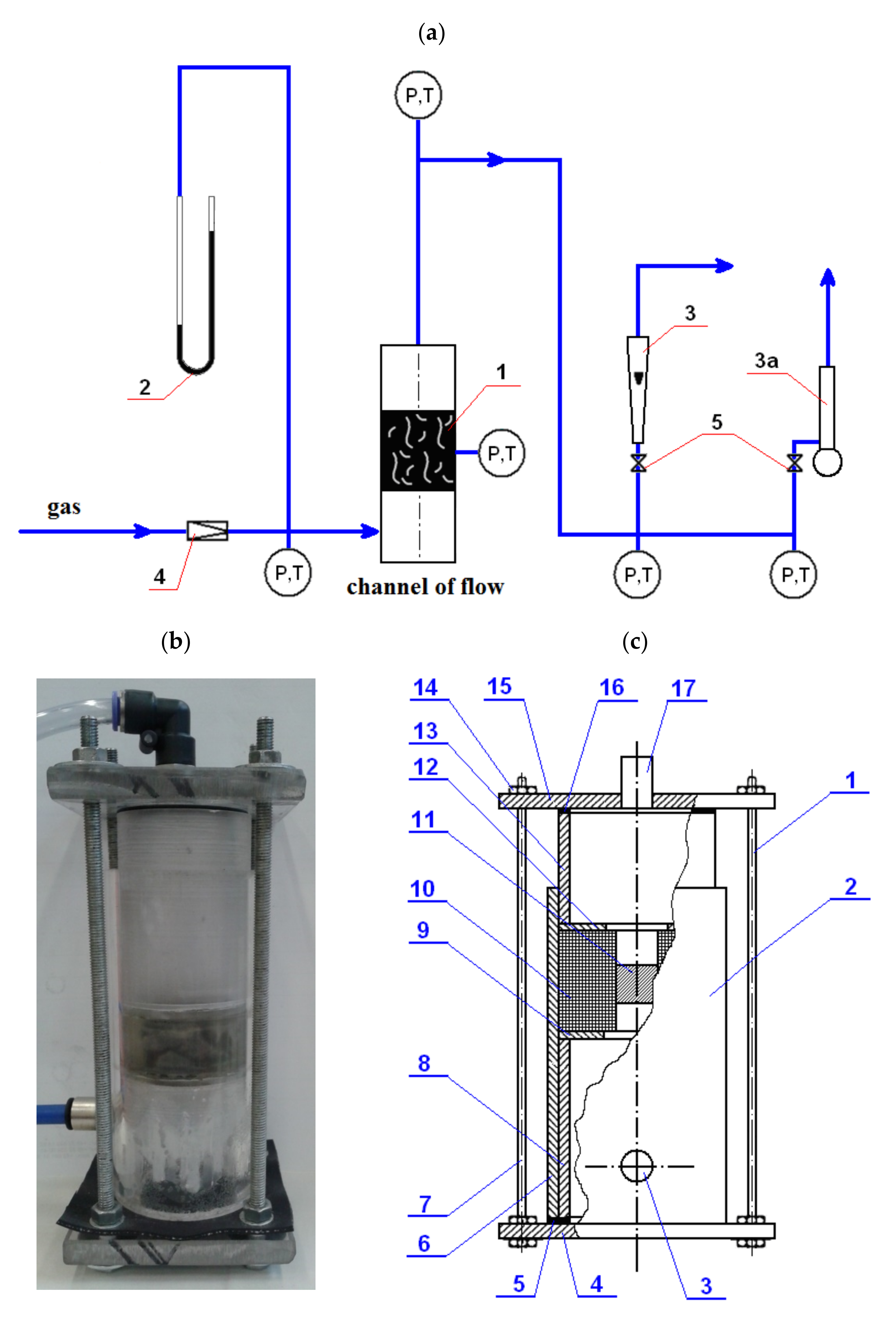
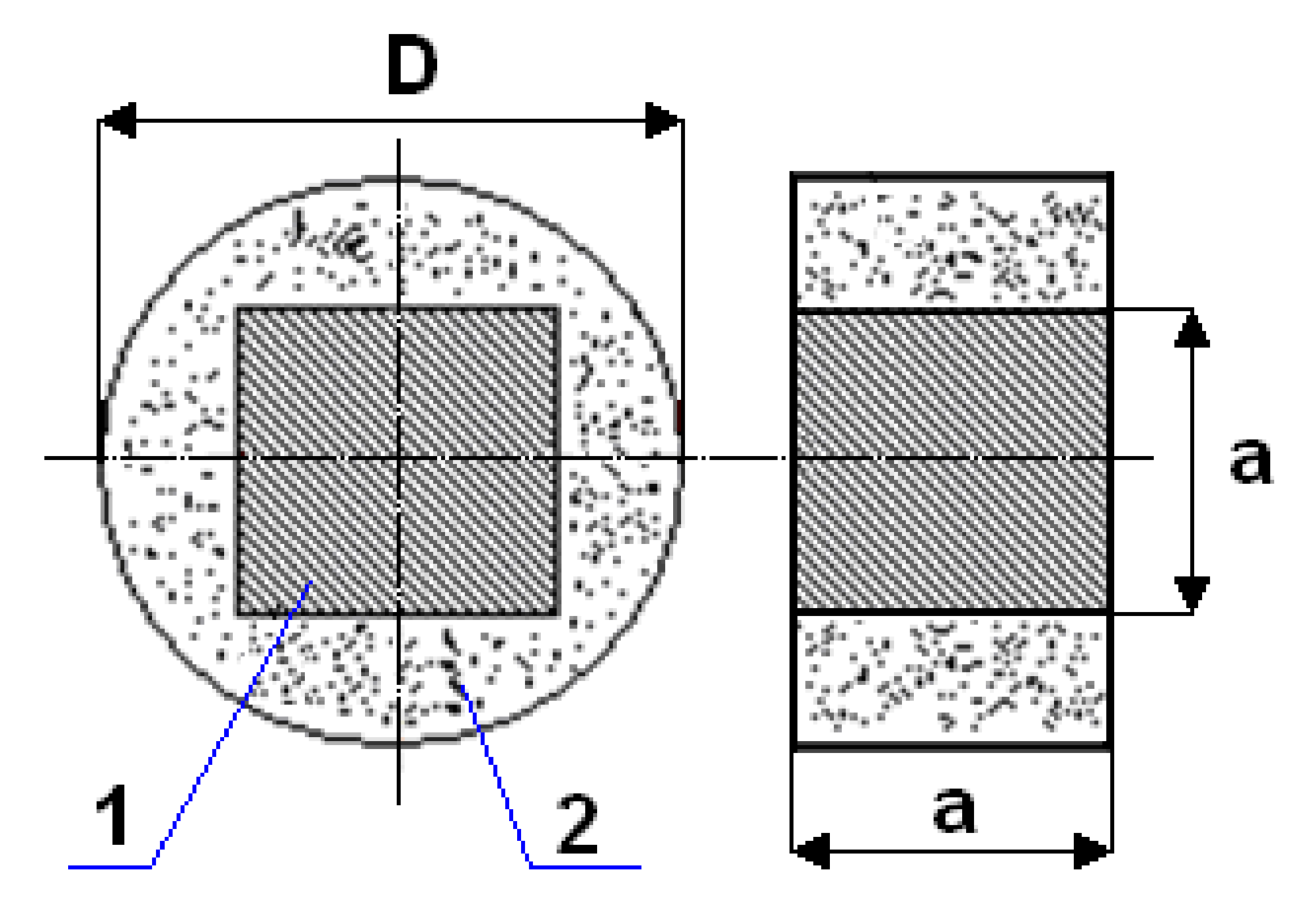
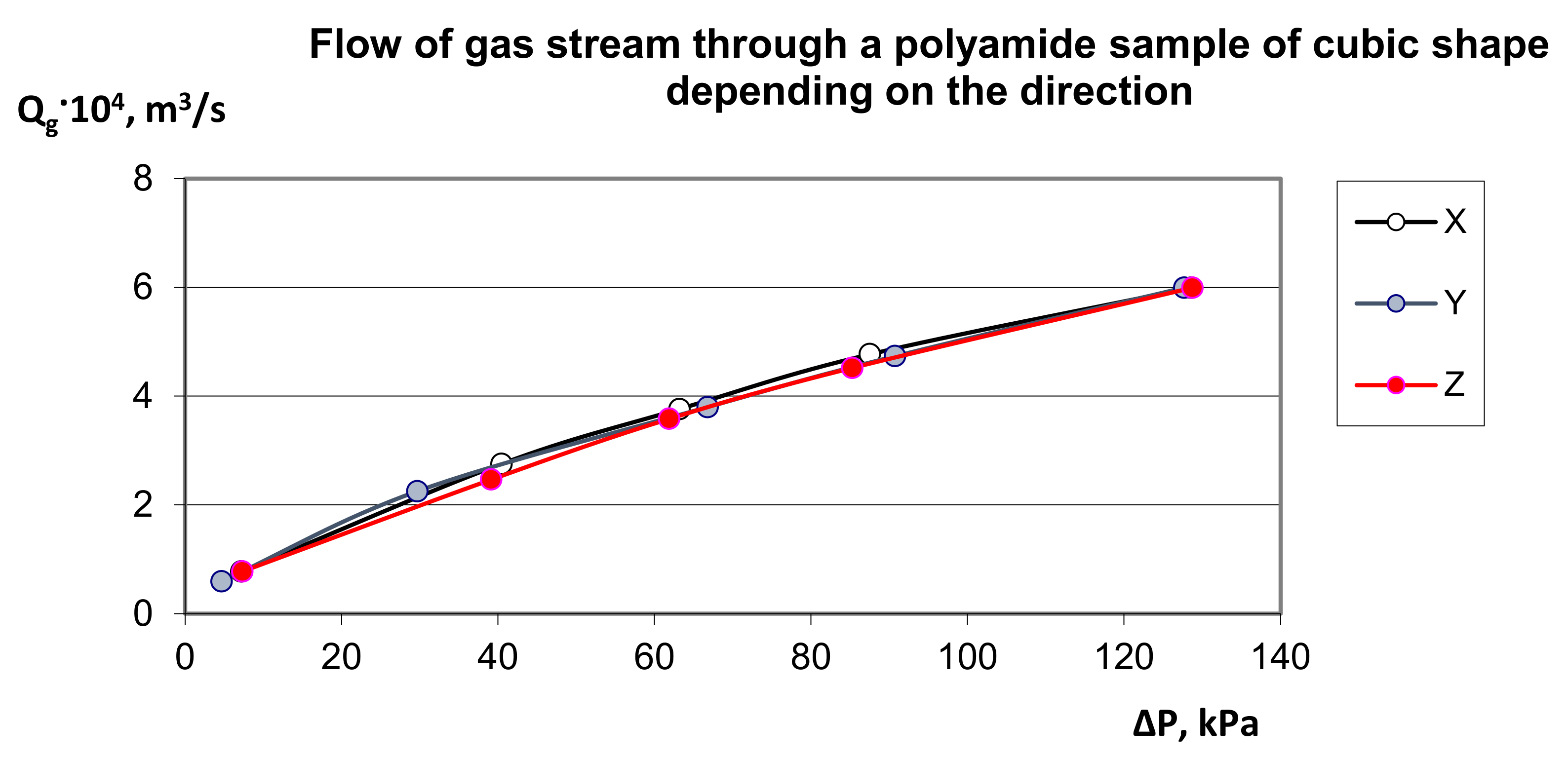
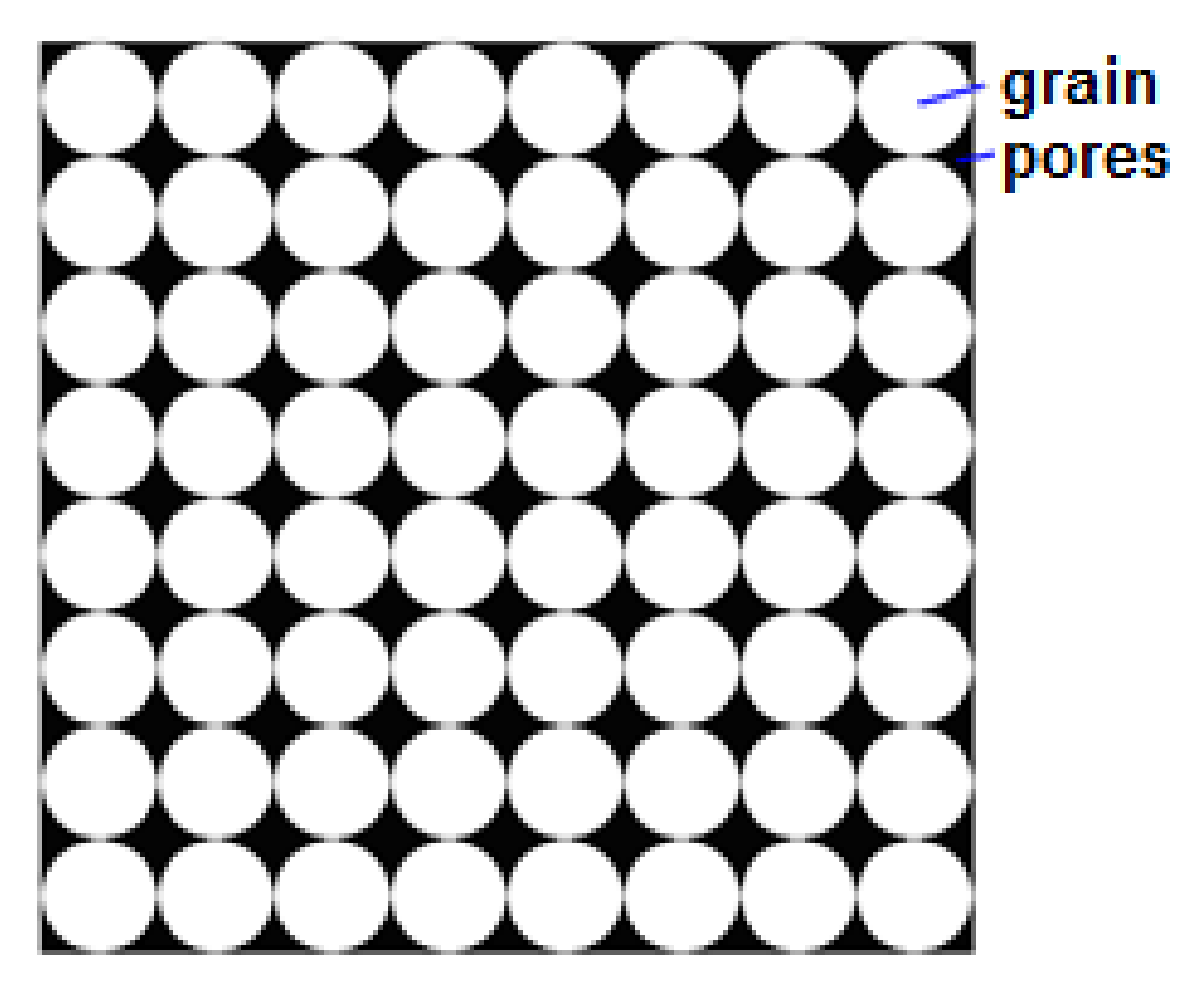
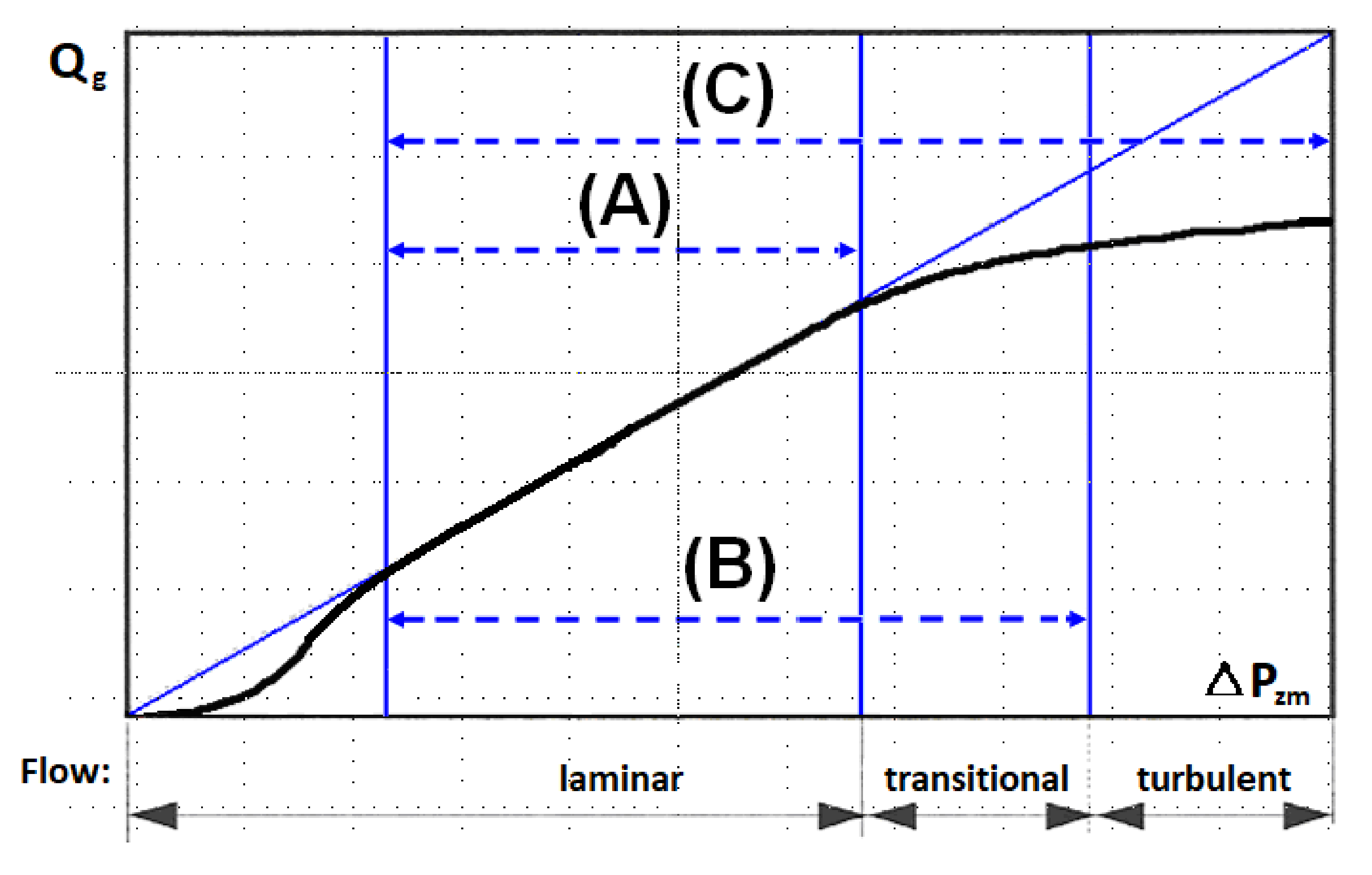
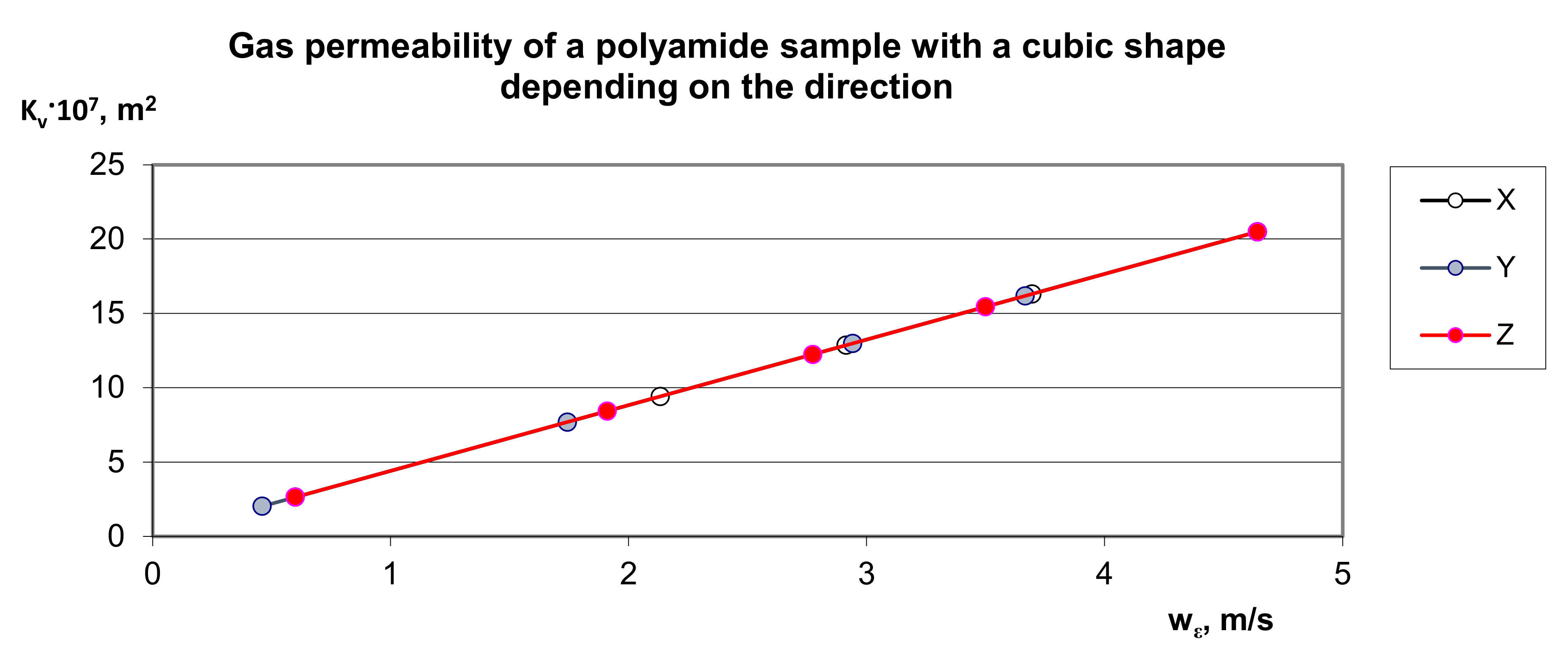
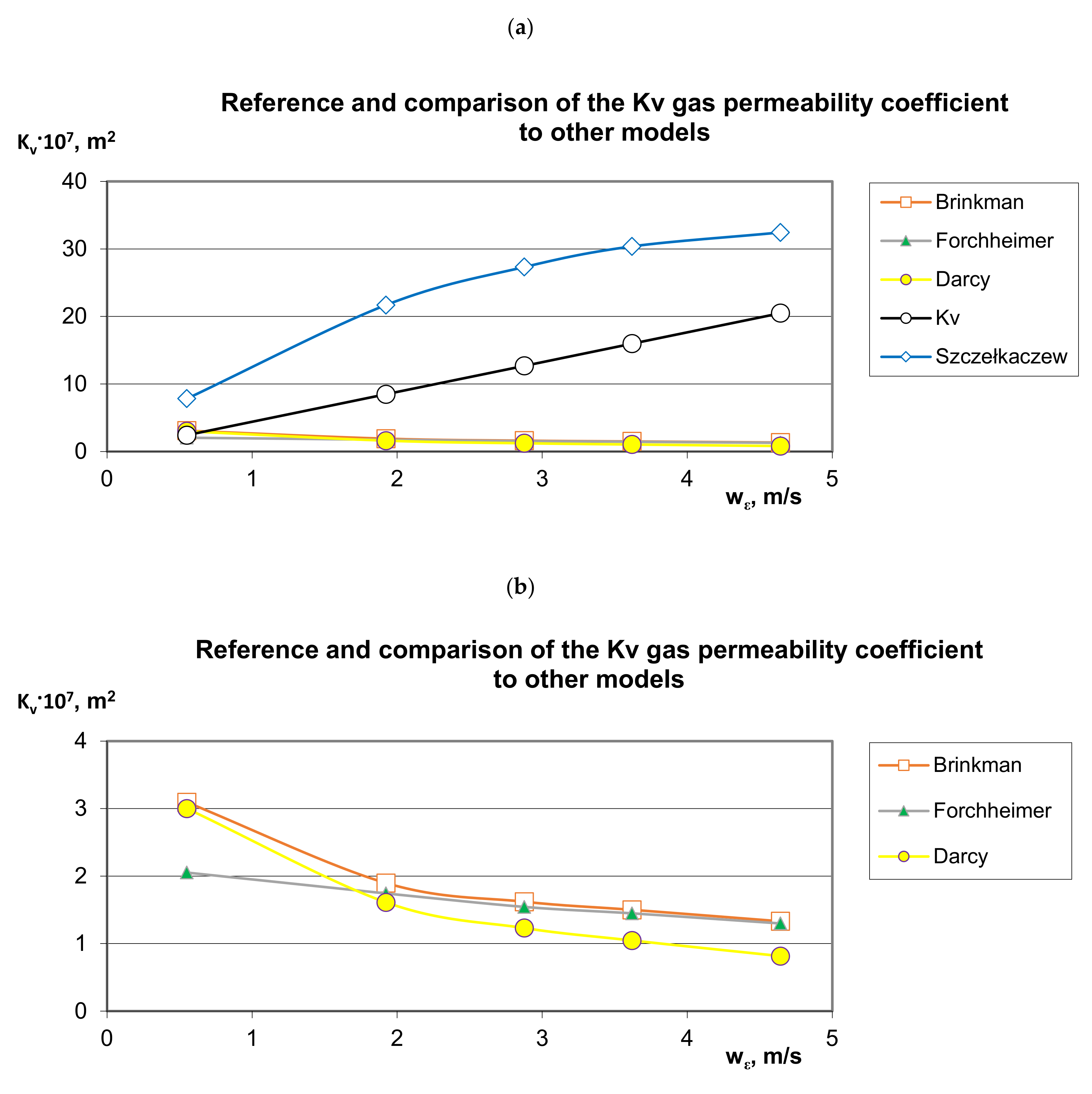
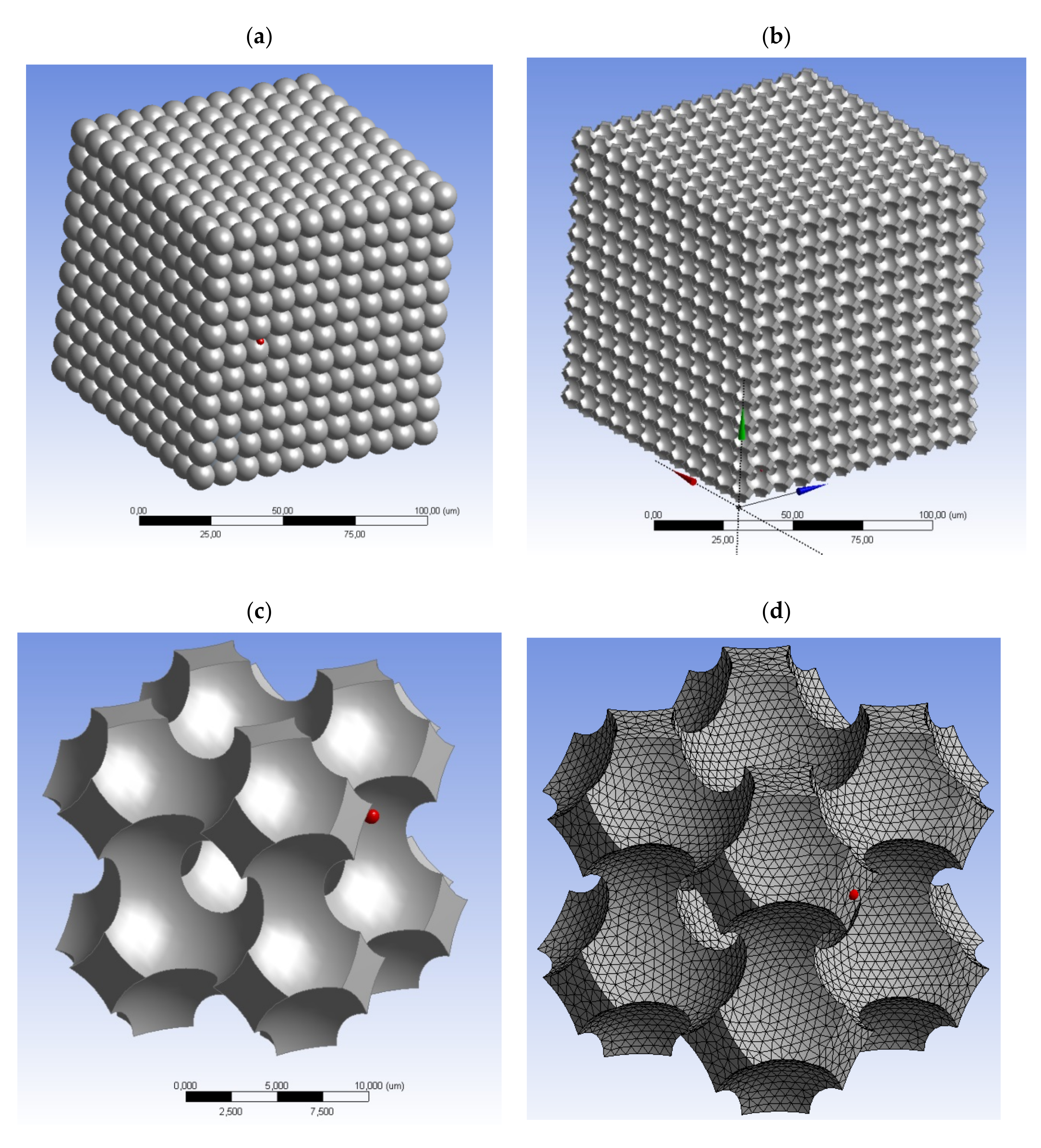
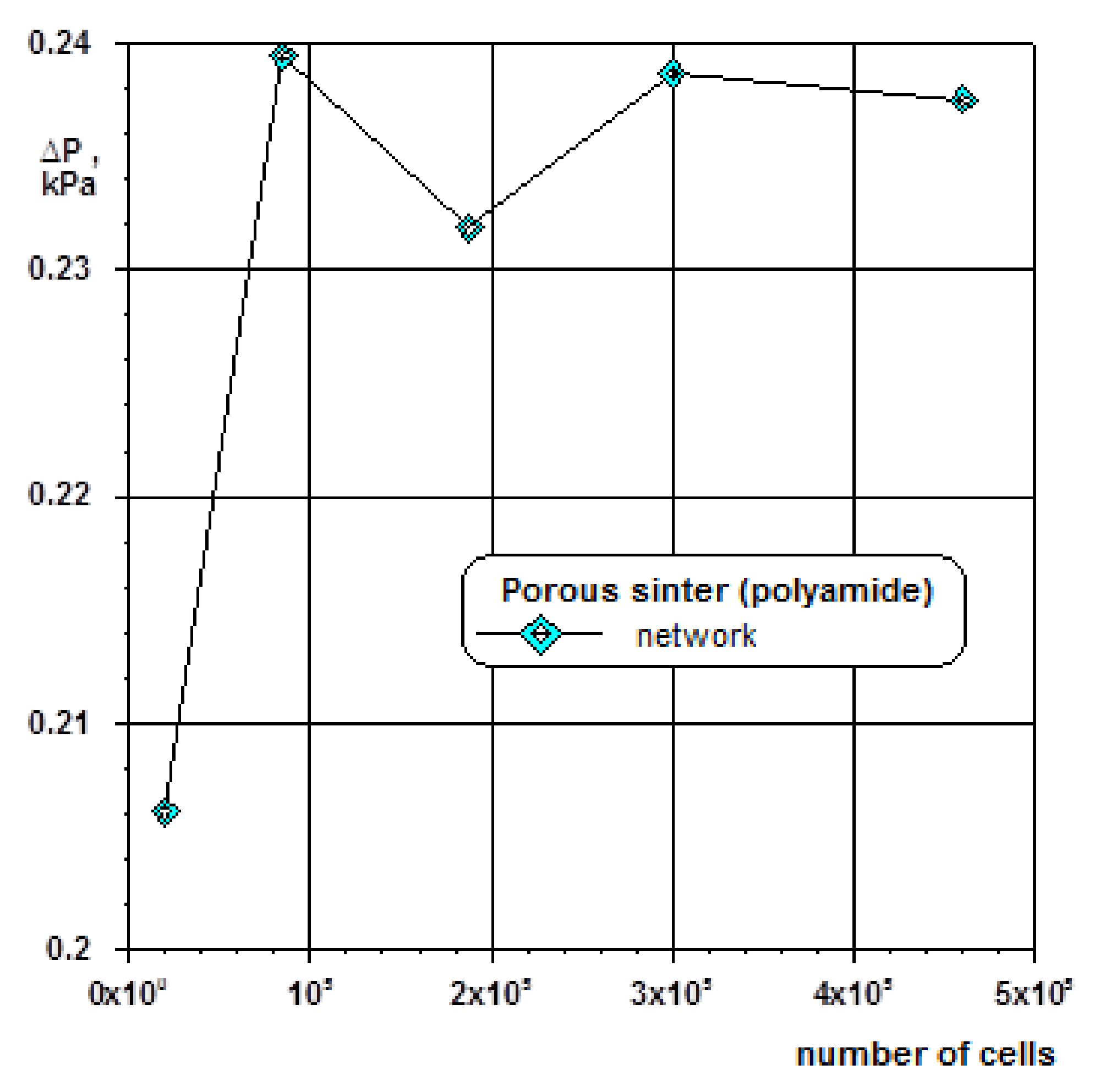
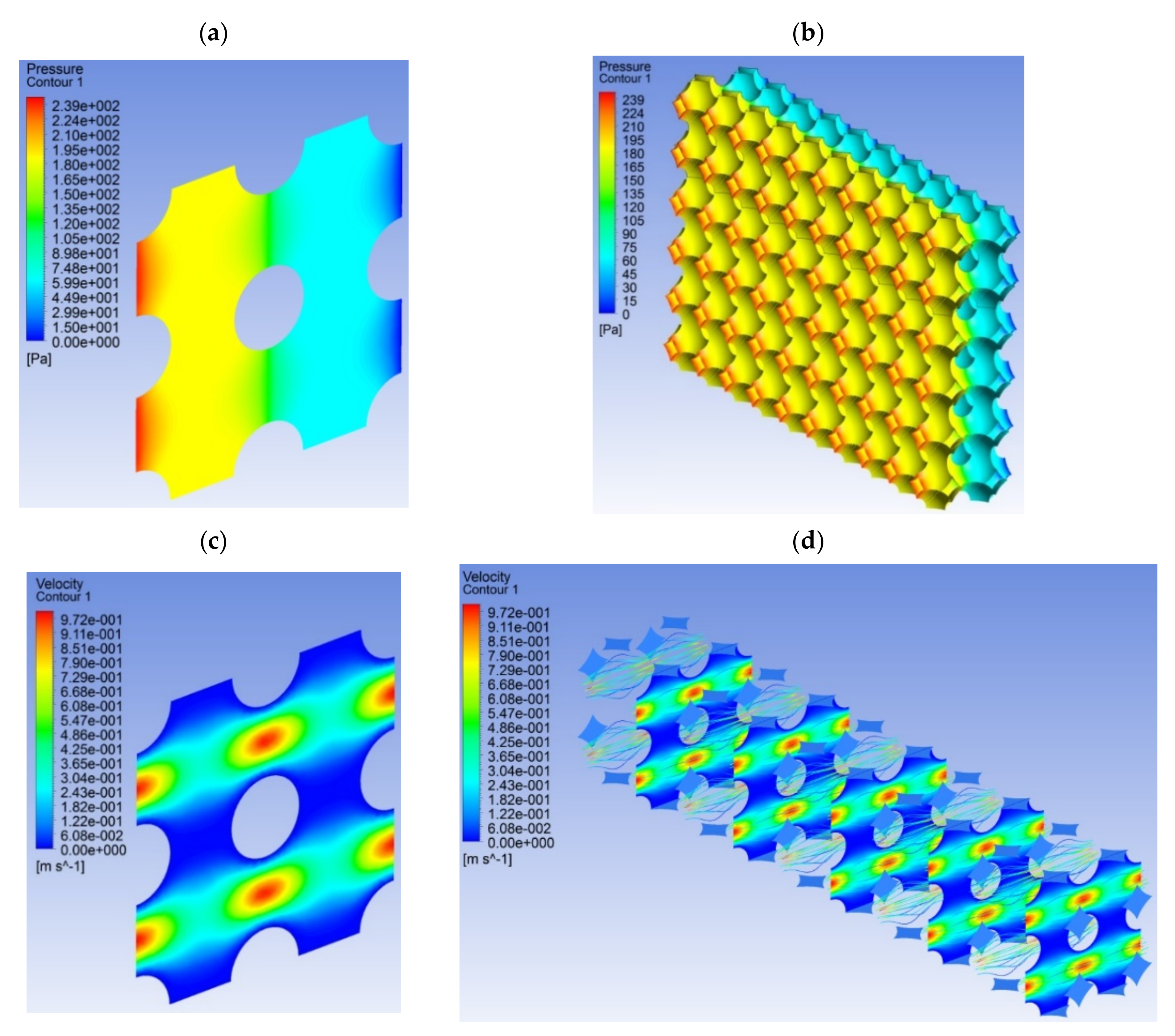
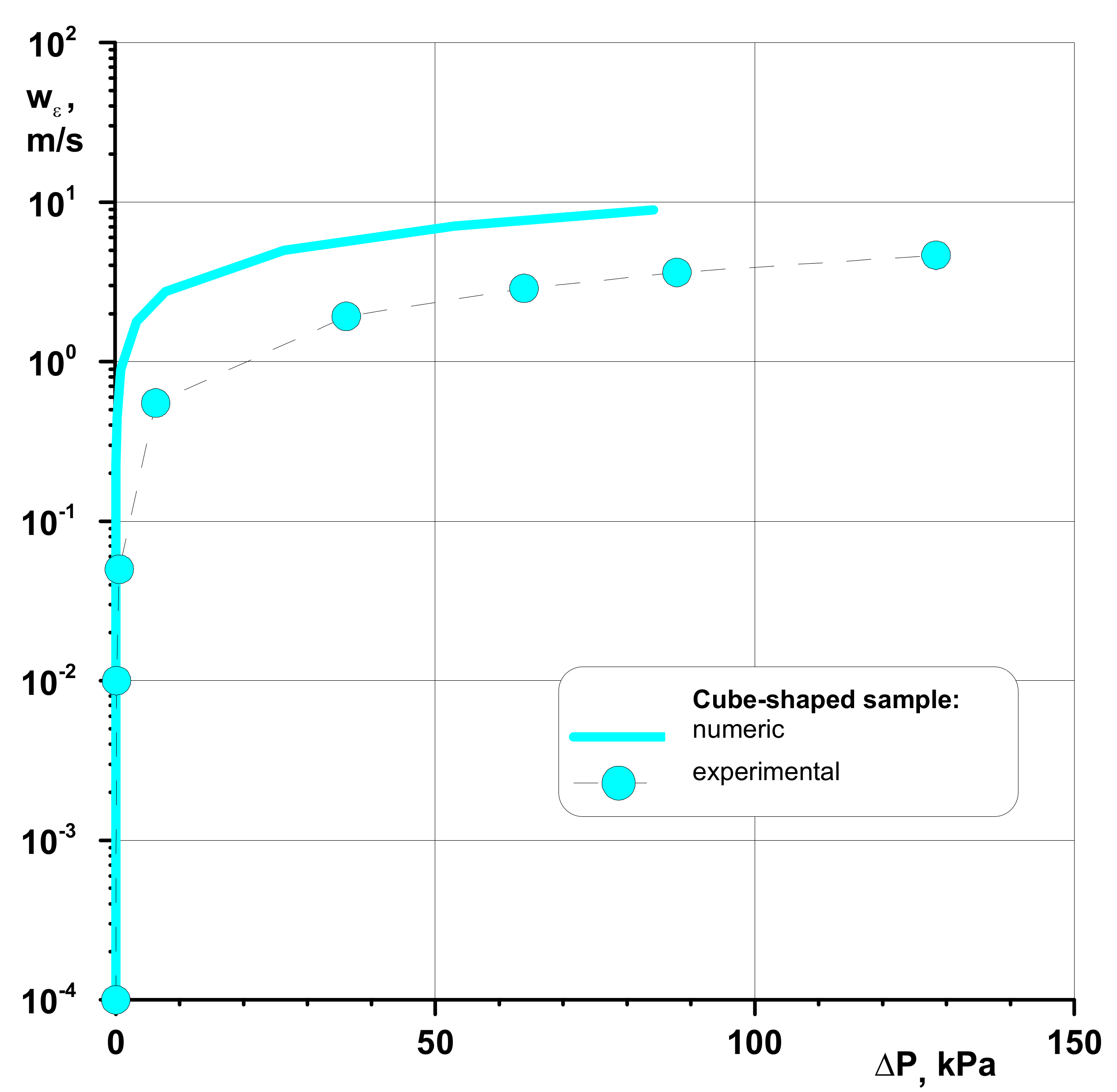
| Porosity Absolute | Equivalent Pore Diameter | Indicator Porosity | Density: | Cubic Solid: | ||
|---|---|---|---|---|---|---|
| Apparent | Skeleton | Volume of the Sample | Equivalent Number of Volume * | |||
| Ψb, % | de, μm | ψ | ϑpoz, kg/m3 | ϑst, kg/m3 | V, dm3 | n |
| 32.3 | 10.0 | 0.5 | 772 | 1140 | 0.008 | 1 |
| Research Material | Porous Sinter (Polyamide) | ||
|---|---|---|---|
| Sample Number | XV-1 | ||
| No. | Reference pressure Po, MPa | Gas stream V∙103, m3/s | Resistance flow ΔPexp, kPa |
| direction of gas flow: X | |||
| 1 | 0.04 | 0.078 | 7.2 |
| 2 | 0.08 | 0.276 | 40.4 |
| 3 | 0.1 | 0.376 | 63.2 |
| 4 | 0.12 | 0.477 | 87.5 |
| 5 | 0.16 | 0.600 | 128.6 |
| direction of gas flow: Y | |||
| 1 | 0.04 | 0.060 | 4.7 |
| 2 | 0.08 | 0.225 | 29.7 |
| 3 | 0.1 | 0.380 | 66.8 |
| 4 | 0.12 | 0.474 | 90.7 |
| 5 | 0.16 | 0.600 | 127.7 |
| direction of gas flow: Z | |||
| 1 | 0.04 | 0.078 | 7.3 |
| 2 | 0.08 | 0.247 | 39.1 |
| 3 | 0.1 | 0.358 | 61.8 |
| 4 | 0.12 | 0.452 | 85.3 |
| 5 | 0.16 | 0.600 | 128.7 |
| average values XYZ | |||
| 1 | 0.04 | 0.071 | 6.3 |
| 2 | 0.08 | 0.248 | 36.1 |
| 3 | 0.1 | 0.371 | 63.9 |
| 4 | 0.12 | 0.467 | 87.8 |
| 5 | 0.16 | 0.600 | 128.3 |
Publisher’s Note: MDPI stays neutral with regard to jurisdictional claims in published maps and institutional affiliations. |
© 2021 by the author. Licensee MDPI, Basel, Switzerland. This article is an open access article distributed under the terms and conditions of the Creative Commons Attribution (CC BY) license (https://creativecommons.org/licenses/by/4.0/).
Share and Cite
Wałowski, G. Experimental and Numerical Studies of Gas Permeability through Orthogonal Networks for Isotropic Porous Material. Materials 2021, 14, 3832. https://doi.org/10.3390/ma14143832
Wałowski G. Experimental and Numerical Studies of Gas Permeability through Orthogonal Networks for Isotropic Porous Material. Materials. 2021; 14(14):3832. https://doi.org/10.3390/ma14143832
Chicago/Turabian StyleWałowski, Grzegorz. 2021. "Experimental and Numerical Studies of Gas Permeability through Orthogonal Networks for Isotropic Porous Material" Materials 14, no. 14: 3832. https://doi.org/10.3390/ma14143832
APA StyleWałowski, G. (2021). Experimental and Numerical Studies of Gas Permeability through Orthogonal Networks for Isotropic Porous Material. Materials, 14(14), 3832. https://doi.org/10.3390/ma14143832






